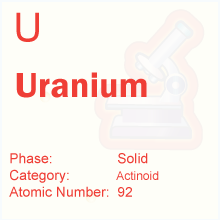 Periodic Table -> Uranium
Periodic Table -> UraniumUranium
Uranium DetailsUranium Symbol: U
Uranium Atomic Number: 92
Uranium Atomic Weight: 238.03
What is Uranium?
Uranium (atomic number 92, symbol U) is a metal and chemical element which occurs in nature as three isotopes - U-234, U-235, and U-238. The metal was discovered in 1789 by Martin Klaproth, a German scientist who also isolated cerium and zirconium.
Properties and Compounds
Uranium forms different compounds such as carbonates and oxides, including triuranium octoxide, uranium trioxide and dioxide, and others. Some of the carbonates are water soluble. It reacts with different metals and forms intermetallic compounds, solids, and solutions. There are several oxidation states, 1, 2, 5, 6, 3, and 4. Uranium is electropositive, ductile, malleable, and silvery-white in color. It has a boiling point of 7468 °F (4131 °C) and melting point of 2070 °F (1132.2 °C). The metal has an orthorhombic structure and is radioactive. It tarnishes quickly when exposed to air.
Occurrence and Recovery
Uranium is found in water, rocks, air, and soil in low concentrations. The element occurs in different minerals, for example, coffinite, torbernite, uranophane, and autunite. There are different recovery methods, and uranium is mainly extracted in ion-exchange and heap leach facilities, in situ recovery facilities, and uranium mills. Conventional uranium mills use chemical and physical techniques for extraction. The mining sites are equipped with evaporation ponds, tailings impoundment, process tanks, and mill buildings. In situ recovery facilities employ chemical techniques for extraction and are used to exploit underground deposits. Surface facilities and features include deep injection wells, evaporation and storage ponds, processing facilities, pipes, header houses, extraction wells, groundwater injection wells, and other features. Pumps, pipes, and evaporation systems are used for waste disposal. Licensed facilities are used for permanent storage. Heap leach facilities use chemical and physical processes, and shallow open pits and deep underground shafts are used for uranium mining. The main producers are Russia, Niger, Namibia, Australia, and Canada.

Uranium has different applications and small amounts are found in household items, photographic chemicals, light bulbs, and ceramic glazes. It is also used to make nuclear weapons and in nuclear power facilities. The element is added to compasses and missile vehicles and is used in microscopy techniques such as TEM which has applications in nanotechnology, materials science, virology, cancer research, as well as semiconductor research. Different radiometric dating techniques are used to estimate age, including uranium-lead and uranium-thorium dating.
Exposure, Health Risks, and Environmental Hazards
Exposure can cause liver damage and cancer. Toxicity and internal radiation occur after long-term exposure to isotopes found in air, water, and food. Uranium may enter major organs and systems such as the bones, kidneys, bloodstream, and lungs and may cause organ damage. There are tests to detect uranium in stool and urine samples, and officers use specialized equipment that helps measure uranium levels in the environment. While people are normally not exposed to high concentrations, persons living or working near industrial facilities, weapon facilities, and mining areas may be at risk. Small amounts are found in root vegetables such as radishes and potatoes when unwashed.
You can
link to this page, using the code below:
Periodic Table |
Banks
© ElementsDatabase.com 2015 | Privacy | About | Contact